Aster
Michaelmas Daisies
We never tire of Aster’s cheerful daisy faces and the profusion of colors and sizes that make up this genus, from 6 ft. giants to tiny dwarf alpines. Our Asters, large and small, are tried and true performers in ordinary garden soil and full sun. Generally late summer bloomers, they provide lots of oomph when many perennials have petered out.
Each $11.50

With a not-too-tall, high-spirited presentation of lavender-blue daisies, this compact, rarely offered Aster should find its way into more gardens.
Sturdy, wine-tinged, open branched stems maintain a pert straight-up stance carrying the big buds and two in. wide, thin rayed flowers. Rising above unusual, large green leaves distinguished by toothed margins, prominent veins and a somewhat fuzzy surface, the long blooming, sunny-eyed blossoms make a vivacious match for the darkly beautiful Sedum ‘Purple Emperor’ above our stone wall.
Blooms late July–October.
Size: 15" high x 15" wide.
Hardy to zone 5.
Blooming long after other flowers have faded, Asters are associated with afterthought and cheerfulness in old age. This Ed Carman selection is one of the largest Asters we offer, with clean-looking foliage right to the ground on strong, upright stems culminating in sprays of blue-violet flowers. Bring cheer to the fading days of summer by planting ‘Bill’s Big Blue’ with Helianthus and other stately late bloomers.
Blooms late September?early November
Size: 4' 0" – 5' 0" high x 3' 0" wide.
Hardy to zone 4.
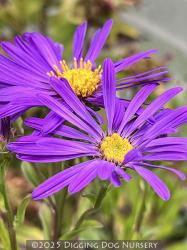
Loved by butterflies, hummingbirds and garden enthusiasts, this marvelous Aster arose from Herbert Oudshoorn′s Dutch-based breeding program. Attractive smooth dark greenery cloaks the bushy mildew-resistant clump whose upright steady stems present vivid, many-rayed violet-blue flowers with saffron-colored eyes. A floriferous choice for borders, bouquets and prairie plantings, ‘Blue Autumn’ tackles deer, bunnies, most diseases and a range of soil types, while judicious pruning ensures its long-lasting, compact good looks. (pp#17,400)
Blooms August–October
Size: 18" – 2' 0" high x 18" – 2' 0" wide.
Hardy to zone 4.
Each $11.50
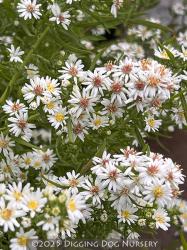
Kudos to Dr. Jim Ault at the Chicago Botanic Garden for this recently introduced distinctive Aster ‘Snow Flurry’ descendant. Fine textured close-knit branches with small, linear green leaves grow upward, then somewhat horizontally before assuming a unique weeping aspect during the summer, which is heightened by a phenomenal bounty of ½ in. wide pure white flowers. The long-lasting floral train nearly veils the entire plant and lays claim to its name, while ‘Bridal Veil’s stoic habit braves drought, salt spray and mildew. (pp#23,966)
Blooms mid-September–early October
Size: 2' 0" high x 4-1/2' wide.
Hardy to zone 5.
Each $11.50

Pretty pink 1-½ in. flowers gather in festive clusters as they top sturdy stems clad in toothed linear foliage. Several layers of frilly petals swirl around the bright yellow eyes, delivering spirited color to the front lines of a perennial border, while Gaura ‘Pink Cloud’ and the darkly red Angelica gigas take up the rear.
Blooms August–early October.
Size: 18" – 2' 0" high x 2' 0" wide.
Hardy to zone 4.
Aster ‘Coombe Fishacre’ (P-0392)
Each $11.50

With a billowy visage, a reliable flowery nature and fine foliage that looks dapper all season long, ‘Coombe Fishacre’ is one of our favorite Asters. Its deep green leaves cover sweeping branches all the way down, while a slew of lilac flowers warmed by rosy-brown centers roost above. Well after the blooms have faded, the seed heads add intriguing colors and shapes. This first-class Aster never needs staking and can be planted in large drifts amid Miscanthus ‘Nippon’, Molinia ‘Bergfreund’ or Eupatorium ‘Gateway’ for glowing pink echoes.
Blooms August–September
Size: 2-1/2' high x 2' 0" wide.
Hardy to zone 5.
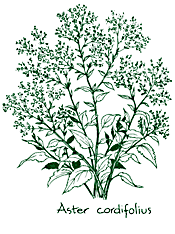
FTD should get to know this perky, rarely seen Aster, and so should you. Buds form early and fool us into thinking they’re about to bloom, but they wait until the plant reaches full height. When it does, a mass of blue-violet on erect, wiry, wine red stems leaves us breathless. Try planting Teucrium f. ‘Azureum’ in front and Molinia ‘Windspiel’ as a backdrop. When flowering ends, we find the stems and seed heads of Aster cordifolius so delightful, we leave them on for winter interest.
Blooms August–early October.
Size: 4' 0" – 5' 0" high x 2' 0" wide.
Hardy to zone 4.
Aster cordifolius ‘Avondale’ (P-1746)
Each $11.50
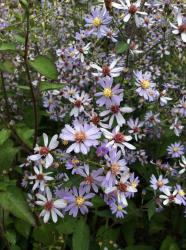
Indigenous to the southern reaches of the Appalachian Mountains, this hearty selection greets fall with a jovial long-lasting barrage of small, yellow-eyed pale lavender-blue daisies atop tidy slender green foliage. Acquiescent to varied light, it exhibits an upright open habit in sunny spots and becomes more relaxed and arching in darker recesses. Ignored by deer, but coveted by butterflies, floral arrangers and gardeners, floriferous ‘Avondale’ endures dry shade once established, favors well-drained soil and can be planted en masse along woodland fringes, meandering amid Geranium ‘White Ness’.
Blooms mid-August–early October
Size: 20" – 2-1/2' high x 18" – 2' 0" wide.
Zone 3/4.
Aster cordifolius ‘Chieftain’ (P-1609)
Each $11.50
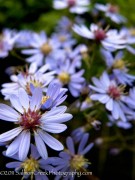
Lifted on tall strong stems, a starry haze of umpteen, tiny, pale lavender-blue daisies lining branched upright sprays earned this impressive celebrity an AGM award and a place in our garden. Rich green tailored foliage stays fresh, while the sunny-eyed flowers lend an ethereal look to the fall landscape that can be juxtaposed against the coarser beauty of Vernonia crinita. Let shrubby roses or more sturdy perennials provide support in the back of the border, otherwise it will need staking or a spring pinching to ensure a shorter stature.
Blooms mid-August – October.
Size: 5' 0" high x 3' 0" wide.
Hardy to zone 4.
Aster cordifolius ‘Little Carlow’ (P-0255)
Each $11.50

‘Little Carlow’ is lush and chipper. Its flowers are larger and a deeper violet-blue than those of Aster cordifolius, and they have bright yellow centers. The green leaves, which reach to the ground, are also broader and darker. It blends well with tall grasses like Calamagrostis and Panicums and contrasts with gold-flowering plants such as Achillea ‘Marmalade’.
Blooms mid-August–early October
Size: 3' 0" – 4' 0" high x 2' 0" wide.
Hardy to zone 4.
Each $11.50

Small white flowers like finely cut daisies, with a yellow center, and elongated heart-shaped, coarsely toothed, dark green leaves, are displayed in large clusters on sinuous, purple-black stems. This Aster is better-known in Europe, where it’s used to light up shady urban gardens. We find it indispensable in the country too, for its tolerance of dry, shady sites. A good plant for the front of the border, try it with Hypericum kouytchense or broad-leafed perennials.
Blooms mid-July–September.
Size: 15" – 18" high x 2' 0" wide.
Hardy to zone 4.
Aster divaricatus ‘Beth Chatto’ (P-2025)
Each $11.50
The sparkling sprays of tiny white daisies with pink-blushed petals plus gilt cocoa-colored centers tarry above sleek, thin, divaricated eggplant-black stems plus stylish, slightly cordate, toothed green leaves. Sprouting from slow-spreading rhizomes, this unique late-blooming Aster is more compact than the species and offers an exquisite delicacy, which the famed Gertrude Jekyll loved to showcase amid Bergenias. ‘Beth Chatto’ prospers in adequately moist shady alcoves, tolerates dry conditions once established and makes a fine-textured addition to bouquets.
Blooms mid-July–September
Size: 18" high x 18" wide.
Hardy to zone 4.
Our anticipation soars as we wait for round buds to finally unfurl a galaxy of small starry blooms twinkling in rose-tinged lilac shades. Beneath the profuse late season display, tiny green leaves stay fresh for months, garnishing stiff branching stems, which angle out and form a well-mannered mound. Illuminated by citron-yellow centers with red streaks, the dainty daisies easily gratify companions like Achillea ‘Hella Glashoff’ or Origanum ‘Bristol Cross’.
Blooms mid-August–September.
Size: 2' 0" high x 18" wide.
Hardy to zone 5.
Aster ericoides ‘Golden Spray’ (P-1610)
OUT OF PRODUCTION AT THIS TIME
Email me when this plant is available
Mirroring autumn’s warmth, this Aster’s unexpected golden floral hues bring a glittery Midas touch to the late season border. Arching branched sprays of copious small daisies with narrow buff white petals and prominent rich yellow centers rise above the well-groomed, dense leafy clump, which makes a congenial neighbor for Astrantias and Pennisetum spathiolatum.
Blooms September – October.
Size: 2-1/2' – 3' 0" high x 2' 0" wide.
Zone 3/4.
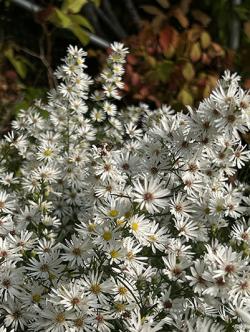
Beloved by late season garden aficionados, florists and butterflies, this exceptional Aster spotlights wispy crisp white clouds of petite yellow-centered daisies hovering above tiny tailored green leaves that form a vigorous shapely clump. ‘Monte Cassino’s delicate illuminated texture becomes a simple-to-place ethereal filler, perfect to juxtapose with bolder perennials such as Persicaria or Crocosmia.
Blooms late August–September
Size: 2' 0" – 3' 0" high x 2' 0" – 3' 0" wide.
Hardy to zone 5.
Aster ericoides ‘Snow Flurry’ (P-2124)
Each $11.50
Boasting both an AGM and a 5-star rating from the Chicago Botanical Garden, this attractive long-lived Heath look-alike was introduced to the United Kingdom by famed English garden designer and author Beth Chatto in 1983. The dense, spreading habit hosts robust, low arching stems with small, stiff, linear gray-green leaves amid a spectacular blizzard of copious petite yellow-eyed white blooms. Kin to the taller North American native, ′Snow Flurry′ makes a prostrate weed-suppressing ground cover that can ramble along a border′s frontlines, sprawl over rocks or trek upon a ledge, where it nourishes late season pollinators plus heroically tackles drought, partial shade, erosion, walnut trees and clay or lean rocky soil.
Blooms September–October
Size: 6" – 8" high x 2' 0" – 3' 0" wide.
Hardy to zone 3.
Aster x frikartii ‘Monch’ (P-0025)
Each $11.50

In some gardening circles, ‘Mönch’ is acclaimed as one of the 10 best perennials. Prolific, 2 ½ in. lavender flowers bloom generously for months on end. The clear shade blends with so many others: lilac-colored Geranium renardii, Ballota pseudodictamnus and Kniphofia ‘Green Jade’.
Blooms July–October
Size: 18" high x 2' 0" wide.
Hardy to zone 5.

Named for a Swiss mountain, this bushy Aster ‘Mönch’ relation arose in 1924 when the savvy Swiss Aster enthusiast, Carl Ludwig Frikart crossed Aster amellus with Aster thomsonii. The compact, slightly shorter stance boasts AGM status plus long-lasting broad sprays of large slender-petaled and gilt-centered lavender-blue daisies poised above handsome oblong-shaped, mounding dark greenery. Delighting butterflies, gardeners and florists alike, ‘Wunder von Stäfa’ can be lodged amid Amsonia ‘Blue Ice’, Crocosmia ‘Solfatare’ and Rudbeckia ‘Viette’s Little Suzy’, where it braves mildew as well as periodic dry conditions, but detests winter wetness.
Blooms July–October
Size: 18" – 2' 0" high x 18" – 2' 0" wide.
Hardy to zone 5.
Aster laevis ‘Bluebird’ (P-1240)
Each $11.50
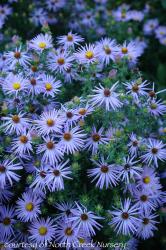
If you are looking for a Aster with engaging late season color, impeccably handsome mildew resistant foliage and a medium-sized frame that never needs staking, look no farther! Clad in glabrous, bluish green leaves, the vase-shaped clump showcases numerous broad, bouquetlike clusters of single, one inch wide, delicately rayed petals gathered by gilded centers. The jubilant floral display is elevated on red-hued stems and seems to cover the entire top half of the plant. Undeterred by varied moisture levels and soil types, ‘Bluebird’ is a Mt. Cuba Center introduction.
Blooms August–October.
Size: 4' 0" high x 2' 0" – 2-1/2' wide.
Hardy to zone 4.
Aster laevis ‘Climax’ (P-0506)
Each $11.50
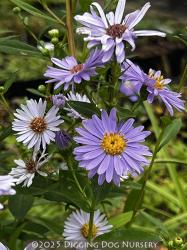
Unfurling later than most Asters, droves of spectacular soft blue-mauve flowers embroidered with yellow eyes signal autumn's arrival on beefy upright stalks. This erect strong growing perennial dons dense dark green leaves that maintain their winsome mildew-free appeal ‘till the caramel-colored seed heads begin to fade. A compelling presence for the mixed border, ‘Climax’ complements other fall bloomers such as Helianthus ‘Dakota Queen’ and Persicaria ‘Fat Domino’.
Blooms mid-September?October
Size: 2-1/2' – 5' 0" high x 2' 0" wide.
Hardy to zone 5.
Aster lateriflorus ‘Bleke Bet’ (P-1303)
Each $11.50
Purchased when we were touring British nurseries nearly 20 years ago and sadly forgotten about, this peerless Aster recently grabbed our attention. Dashing, deep purple-infused green foliage and dense well-branched twiggy stems lift an exuberant profusion of small, rose-centered white daisies, whose fine-hewn petals mature with soft pink shades. Strong, tall and upstanding, seldom offered ‘Bleke Bet’ delivers late, long-lasting flowers plus refined texture, while escorting companions such as Eryngium yuccifolium and Calamagrostis ‘Cheju-Do’.
Blooms September–October
Size: 4' 0" – 4-1/2' high x 3' 0" wide.
Hardy to zone 4.

Shrouded in mysterious tiny black-purple foliage, ‘Lady in Black’ offers sprays of small white flowers with a healthy blush of pink. Unlike ‘Prince’s tight clumping habit, this Dutch lady’s elegant and tall upright stems will spread slowly over time.
Blooms September–October
Size: 3-1/2' – 4' 0" high x 3' 0" wide.
Hardy to zone 4.

This classy fine-textured Aster is cherished as much for its myriad late season blooms as for its bushy, ebony-infused purple foundation. Stiff horizontal branches plus dashing, narrow leaves cushion the buoyant display of petite white daisies embroidered with mulberry-hued centers. A flower-laden grace note in the autumnal border, ‘Prince’ can be surrounded by loyal subjects such as Persicaria ‘Blackfield’ and Phlomis tuberosa.
Blooms September–October
Size: 2-1/2' – 3' 0" high x 2-1/2' – 3' 0" wide.
Hardy to zone 4.
Aster lateriflorus ‘White Lovely’ (P-1366)
Each $11.50
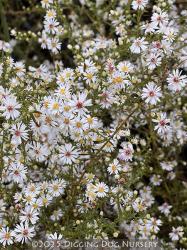
A preeminent star of the fall show, ‘White Lovely’ entertains petite, thin-petaled white daisies tinged lilac when mature and brightened by sunny-side-up yellow eyes. The copious, late summer flowers are borne along horizontally branched leafy sprays of arching and wide-angled, purple-streaked stems with small, slender dark green foliage that never tuckers out.
We like to plant Monarda ‘Violet Queen’ and Melianthus ‘Antonow’s Blue’ behind while headlining this elegant Aster right up front.
Blooms August–early October.
Size: 2-1/2' high x 2-1/2' wide.
Hardy to zone 4.
Aster macrophyllus ‘Albus’ (P-2176)
Each $11.50
A friend to bees, butterflies and flower arrangers, delightful umbels of countless yellow-centered, starry white flowers twinkle atop lean straight purple-tinted stems. Winsome heart-shaped deep green leaves forge a bushy compact ground cover-like habit that’s sustained by sturdy rhizomes. Selected from the eastern North American native, this easy-care weed-quelling perennial flourishes in light shade plus tolerates tree roots, making it the go-to choice for skirting beneath Amelanchier ‘Smokey’ or Viburnum ‘Mary Milton’.
Blooms August–October
Size: 2-1/2' – 3' 0" high x 2' 0" – 2-1/2' wide.
Zone 3/4.
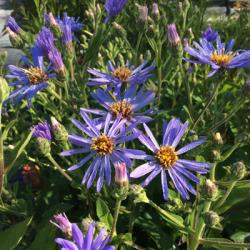
A “real winner” is how the late celebrated plantsman and author Christopher Lloyd described this form of our versatile eastern North American native Aster. Slow-spreading rhizomes plus toothed heart-shaped leaves compile an attractive green basal rosette, bearing upright red-imbued stalks and broad, openly branched flat-topped clusters of rich lavender-blue daisies with yellow centers that age to rose. Flower-laden, mildew-free and amenable, ‘Twilight’ can be massed at a woodland’s edge and be added to cottage gardens or perennial borders, where it tolerates dry shade.
Blooms August–September
Size: 2-1/2' – 3' 0" high x 18" – 2' 0" wide.
Zone 3/4.

Bred by Mr. Hilliard from Williamsburg, Iowa and celebrated by Graham Stuart Thomas for its ample “garden charm,” this well-loved Aster highlights pink flowers and a tall profile. Lavish quantities of dainty gold-centered daisies, each house nearly 50 layered finely cut rays, while cresting thick straight, somewhat woody, branched stalks. The robust grayish green clump, crowded with stem-clasping, bristle-rough, 4 to 5 in. long leaves, tolerates wet soil and some shade, resists mildew and looks lovely next to Sedum ‘Indian Chief’ and blue-blooming Asters.
Blooms August–September
Size: 3' 0" – 5' 0" high x 2' 0" – 3' 0" wide.
Hardy to zone 3.
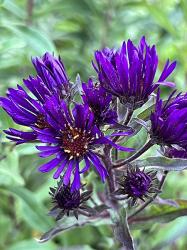
Clothed in tasteful fine-haired lanceolate greenery, a rounded bushy base of tall, upright sturdy stems supports ′Nachtauge′s striking late season floral fete. Slender lanky petals dancing around saffron and russet-hued centers plus decorative recurved calyces describe the dark-as-night purple flowers. Selected by German plantsman Till Hofmann, this mighty perennial lends regal richly-hued grace notes to fellow back-of-the-border cohorts such as Helianthus ‘Sheila’s Sunshine’ and Eupatorium ‘Riesenschirm’.
Blooms September–October
Size: 3-1/2' – 5' 0" high x 20" – 2-1/2' wide.
Hardy to zone 4.
Aster novae-angliae ‘Purple Dome’ (P-0175)
Each $11.50
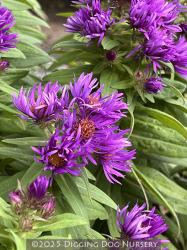
Lose yourself, like the linear, dark green fuzzy foliage, in a sea of royal purple flowers held on erect stems. Mildew resistant, compact and bushy, the handsome symmetrical mound becomes engulfed with 1-½ in. wide, golden-eyed, vividly colored daisies in a truly breathtaking spectacle, especially when planted en masse.
Dr. Richard Lighty developed this easy-care, late season show stopper that makes a sterling addition to arrangements and a captivating counterpoint to Stipa arundinacea.
Blooms August – early October.
Size: 18" high x 18" – 2' 0" wide.
Hardy to zone 3.

Copious clusters of fine-rayed, plush dark purple flowers with large butterscotch-colored discs are buoyed by ‘Violetta’s tall, close-knit stand of straight mighty stems. Beneath the nearly iridescent star-like blooms, dashing lance-shaped green leaves garb the vigorous, somewhat woody clump. This stately New England native resists mildew, cherishes sun, handles some shade, nourishes pollinators and birds plus splashes luxuriant late season color amid fall borders, butterfly gardens and prairie-style plantings.
Blooms August–October
Size: 4' 0" – 5' 0" high x 2' 0" – 3' 0" wide.
Zone 3/4.

This Aster’s alluring flowers promise a late season hurrah. Supported by stiff branching stems lined with verdant linear foliage, the blooms are the size of silver dollars, and layers of their snug vibrant blue-violet petals radiate from yellow and maroon centers. ‘Blue Danube’ lends an air of elegance in the midst of Calamagrostis brachytricha and Angelica gigas.
Blooms September–early October
Size: 3' 0" high x 2' 0" wide.
Hardy to zone 5.
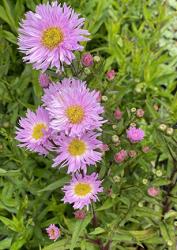
Stepped in luscious pink shades, splendid double flowers feature lime-colored eyes encompassed by layers of slim petals that later twist and curl, becoming fuller and more shapely with age. Tasteful lance-shaped dark green leaves and slender branched stems fashion an upright, bushy foundation beneath the bountiful nectar-rich blooms. A well-endowed diva for the fall garden, this robust AGM recipient can romp around Eryngium ‘Blue Glitter’ and Festuca ‘Eilers Beauty’.
Blooms late August–October
Size: 3' 0" high x 18" – 2' 0" wide.
Hardy to zone 5.
Aster novi-belgii ‘Schneekissen’ (P-2271)
Each $11.50
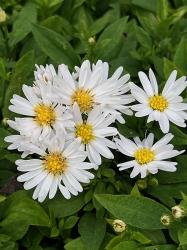
An unparalleled profusion of petite long-petalled snow-white daisies brightened by pronounced egg-yolk-colored centers is this peppy Aster′s claim-to-fame. Enticing bees, butterflies and other beneficial insects, sparkling early autumn flowers engulf upright branched stems and narrow, lance-shaped green leaves that snugly garb the dwarf cushion-like mound. Tailor-made for small well-drained gardens and other tight nooks, ′Schneekissen′s compact stance can adorn rockeries, soften pathway edges, nestle against steps and roost in containers, where it tolerates coastal sites plus dry conditions.
Blooms September–October
Size: 9" – 12" high x 9" – 12" wide.
Hardy to zone 4.
When this cultivar first bloomed in our garden, we were delighted to see such large flowers! A breathtaking contrast of pure white blossoms against handsome, verdant foliage with wine-colored veins creates a presentation even more spectacular than that of ‘Climax’. Combine with Origanum ‘Ed Carmine’ for a showy summer farewell.
Blooms September–early October
Size: 2-1/2' – 5' 0" high x 2' 0" wide.
Hardy to zone 5.
Aster oblongifolius ‘Dream of Beauty’ (P-1874)
Each $11.50
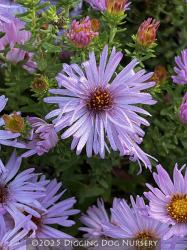
Introduced in 1960 by the legendary South Dakota-born cattle rancher and plantsman Claude Barr, this hard-working native plains Aster may be small on stature but is big on bloom. Densely-arranged low-spreading gray-green leaves weave a vigorous sturdy base that puts on a mighty fine fall showing of sweet sugary pink daisies with burnt orange centers. Withstanding drought, some afternoon shade and a wide range of soil, including clay, ‘Dream of Beauty’s remarkable floral output and tailored compact habit can be staged atop a garden wall or along a pathway.
Blooms September–October
Size: 12" high x 18" – 2' 0" wide.
Hardy to zone 4.
Aster oblongifolius ‘October Skies’ (P-1241)
Each $11.50
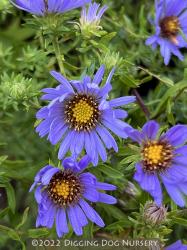
Named for the copious, fine rayed, sunny-centered daisies, mirroring the azure atmosphere of a New England fall day, this Aster was also selected for its trim short stature and easygoing, stalwart disposition. Small, narrow green leaves emit a light scent when handled and form a low, close-knit bushy mound that abides dry, rocky or sandy soil. While the species is one of the last wildflowers to bloom in the eastern U.S., ‘October Skies’s lavender-blue flowers maintain their good looks after an early frost, lend jaunty accents to bouquets and beckon the butterflies.
Blooms September–October
Size: 18" high x 18" – 2' 0" wide.
Hardy to zone 5.
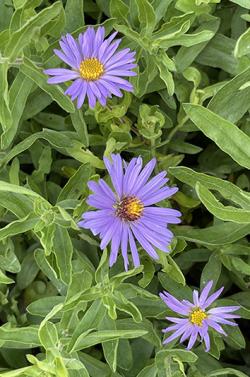
Mr. Raydon Alexander of San Antonio, Texas, said this hearty mint-scented Aster was his favorite, and we’re sure you’ll agree. Originating near Lookout Mountain, Tennessee, drought tolerant ‘Raydon’s Favorite’ quickly forges a valiant, dense mound that gets buried under multitudes of bright blue-lavender daisies. With late richly colored flowers, distinguished by sunlit yellow eyes and fine-textured single rays, and a no-fuss, orderly nature, it proves indispensable in the fall border.
Blooms September – October
Size: 3' 0" high x 2' 0" wide.
Zone 3/4.
Aster ‘Ochtendgloren’ (P-1087)
Each $11.50
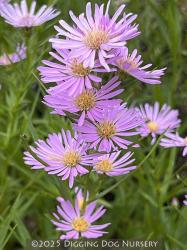
Conjuring a zestful spirit as summertime wanes, this elegant Aster parades branched heads of dainty pink starlike blooms and darker pink buds. The long and narrow, densely set foliage that lines its stiff, sturdy stems is handsome right to the ground. Claiming Aster pringlei lineage, ‘Ochtendgloren’ merrily partners with Pennisetum ‘Moudry’ and Geranium ‘Buxton’s Variety’ in front of our Beech hedge.
Blooms August–early October.
Size: 4' 0" – 5' 0" high x 2' 0" – 3' 0" wide.
Hardy to zone 4.
Meandering throughout central and southeastern North American prairies, fields, rocky slopes and woodland margins, this intrepid beauty was discovered along Ohio’s Oolentangy River in 1835 by botanist John Riddell. Low-growing, thick green basal foliage—rough-to-the-touch, long-petioled and somewhat cordate at the base—gives way to an eye-catching burst of sprightly 1 in. wide, blue-rayed and yellow-eyed daisies on firm upright branching stems that are loosely lined with smaller lanceolate upper leaves. Aptly named Sky Blue Aster conquers drought and poor soil, appreciates superb drainage and assures enduring verve in mixed borders, butterfly gardens, native plantings or cut arrangements.
Blooms September–October
Size: 2' 0" – 3' 0" high x 18" – 2' 0" wide.
Hardy to zone 3.
Each $11.50

Sharing lineage with ‘Calliope’ as well as Aster novi-belgii, this seldom-offered Aster presents a riveting display of large vibrant violet-blue flowers donning gold and reddish brown stamens. Tailored bushy foliage attires sumptuous maroon stems beneath the late season, larger-than-average blooms. Tolerant of some shade and dry periods once established, hearty ‘Orpheus’ can grace a bouquet or mosey alongside Liatris ligulistylis and Rudbeckia ‘Loofahsa Wheaten Gold’.
Blooms August– early October
Size: 4' 0" high x 18" wide.
Hardy to zone 5.
Aster pyrenaeus ‘Lutetia’ (P-0631)
OUT OF PRODUCTION AT THIS TIME
Email me when this plant is available
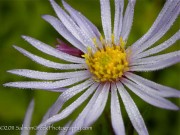
‘Lutetia’ is one of our favorite low growing Asters, and by summer’s end you’ll see why. Its pink buds open into a charming blanket of large, yellow-centered, pastel daisies with delicately splayed lavender petals, completely hiding the loose mound of finely textured foliage and intertwined, wiry, deep purple stems.
Blooms August–October
Size: 18" high x 2' 0" wide.
Hardy to zone 6.
Aster tataricus ‘Jindai’ (P-0632)
Each $11.50
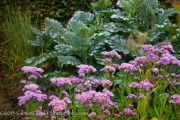
The name may sound like one of the bad guys from Star Wars, but this unique Aster is definitely on our side with its upright bearing and lush textural appeal. Not as towering as its moisture-loving Asian counterpart, ‘Jindai’ spawns huge, serrated rough-to-the-touch leafage on shorter stout stalks and abundant branched sprays of late-blooming violet flowers engraved by large saffron eyes. A stand-alone for the mixed border, its assertive look can offset finer textured plants like Spiraea ‘Ogon’ and Phlox ‘David’.
Blooms September–November
Size: 3' 0" high x 2' 0" wide.
Hardy to zone 3.
Aster tongolensis ‘Napsbury’ (P-2132)
Each $11.50
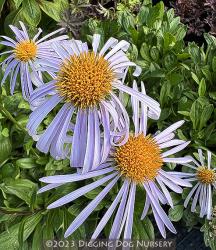
Cavorting in rocky alpine meadows from Western China to Nepal, this fetching Himalayan denizen sprouts a low, long-lived mound of hairy dark green foliage. Numerous nearly leafless, erect 18 in. stems, each lift a singular, large violet-blue flower distinguished by perky egg-yolk-colored centers and slim, spaced petals that elegantly flex downward as they mature. A delight to birds, butterflies and plant lovers, ‘Napsbury’s smaller slow-spreading stature is tailor-made for the front of the border, a rockery or well-drained cottage garden.
Blooms May–July
Size: 18" high x 2' 0" wide.
Hardy to zone 4.
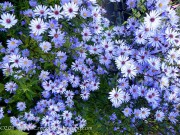
With a carefree cant, green, lance-shaped leaves have a lively look all season. Lean, dark violet-streaked stems give way to airy, lavender-colored sprays of glassine blossoms whose open petals are caught in a vivid yellow center. The red hues in the stems of Panicum ‘Shenandoah’ and Echinops enliven this Aster’s rich verdure.
Blooms September–October.
Size: 4' 0" high x 2' 0" wide.
Hardy to zone 3.
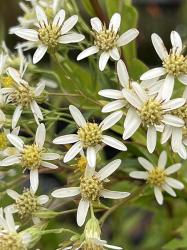
Prized for an ebullient white floral display that’s both early and long lasting above plucky green leaves and an amenable pest-free bent, this mostly eastern American native gives you good reason to usher it into your garden. The straight staunch stalks yield ovate to lanceolate-shaped leaves beneath niveous, flat-topped branching clusters of spaced, thin-rayed flowers with creamy yellow centers. Beloved by bees and butterflies, Aster umbellatus is well-suited for cottage gardens, nectaries and sunny perennial borders, favoring moist sandy sites but adapting to dry conditions as well as clay soil and some shade.
Blooms August–September
Size: 4' 0" high x 2' 0" wide.
Hardy to zone 3.

A floriferous cultivar of our native Aster, ‘White Swan’ promises dense sprays housing profuse thin-rayed white blossoms with prominent saffron-hued centers. Slender, branched upright stems and narrow, lance-shaped green leaves fashion an attractive bushy base beneath the light-hearted late season pomp that tempts bees, birds, butterflies and floral designers alike. Heightened by maroon-tinged fall foliage plus pouffy seed heads, this winsome clump-forming perennial appreciates sun, adequate moisture, good drainage, average fertility and proper air flow.
Blooms September–October
Size: 2-1/2' – 3' 0" high x 18" – 22" wide.
Hardy to zone 4.












